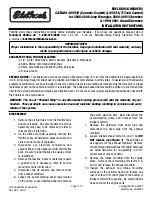
Recommended shift speeds
Downshift according to the following charts for your specific
engine/drivetrain combination:
Upshifts when accelerating (recommended for best fuel economy)
1-2
22 km/h (14 mph)
2-3
40 km/h (25 mph)
3-4
55 km/h (34 mph)
4-5
70 km/h (44 mph)
Upshifts when cruising (recommended for best fuel economy)
1-2
19 km/h (12 mph)
2-3
31 km/h (19 mph)
3-4
46 km/h (29 mph)
4-5
61 km/h (38 mph)
Reverse
1. Make sure that your vehicle is at a complete stop before you shift into
R (Reverse). Failure to do so may damage the transmission.
2. Move the gearshift lever into the neutral position and wait at least
three seconds before shifting into R (Reverse).
•
The gearshift lever can only be moved into R (Reverse) by moving it
from left of 3 (Third) and 4 (Fourth) before shifting into R (Reverse).
This is a lockout feature that protects the transmission from
accidentally being shifted into R (Reverse) from 5 (Overdrive).
Parking your vehicle
1. Apply the brake and shift into the neutral position.
2. Fully apply the parking brake, then shift into 1 (First).
3. Turn the ignition off.
Do not park your vehicle in Neutral, it may move unexpectedly
and injure someone. Use 1 (First) gear and set the parking brake
fully.
Removing the key
Turn the ignition off, push the release lever (located above the ignition),
then turn the key toward you and remove the key.
2003 P207 Explorer Sport Trac
(p27)
Owners Guide (post-2002-fmt)
USA English
(fus)
Driving
118
Summary of Contents for 2003 P207 Explorer Sport Trac
Page 216: ...216...
















































